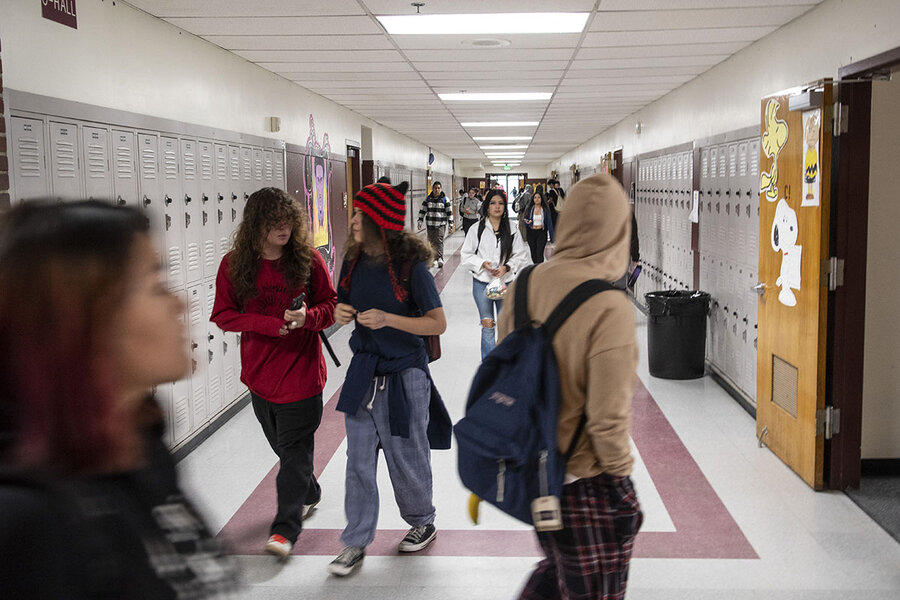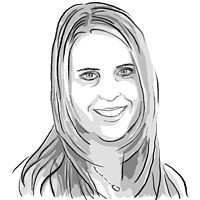What can high schools learn from their post-pandemic upperclassmen?
Loading...
It’s no secret the pandemic hit many students hard – emotionally, academically, or both. Test score data shows precipitous drops in reading and math skills. Thousands of students are “missing” from the public school population. And the Centers for Disease Control and Prevention released a report in February detailing increased youth mental health challenges, particularly among teen girls and LGBTQ+ teens.
And especially for juniors and seniors, whose high school experience has been defined by the pandemic, a return to academic demands and routines hasn’t erased the past few years. As these upperclassmen ease out of their K-12 career, one question coming to the fore is: Are there lessons districts can draw that may help the younger generations coming after them?
Why We Wrote This
A story focused onWhile everyone hoped getting students back in class would help, there was no automatic return to normalcy. What can school systems learn from students nearing the end of high school experiences defined by the pandemic?
Bella Alvarado, a senior at Hilltop High School in Chula Vista, California, spent the pandemic caring for injured and ill relatives and teaching her younger brother and cousins. Back in class, she sees a desire among students to work at their own pace and be more selective about what they learn.
Bella observes that teachers, students, and the system have all changed.
“There’s no such thing as going back to education before COVID,” she says. “I strongly believe that nothing will ever be the same.”
Like generations of students before her, Bella Alvarado, a student at Hilltop High School in Chula Vista, California, approaches the end of her senior year with mixed feelings.
Proud of her accomplishments and excited for new adventures? Yes. Ready to say goodbye to her childhood and part with friends? Not quite.
For Bella, who was looking forward to “being a kid again,” in-person schooling has been a mixed bag – some normal moments and some big differences. It took time to make new friends, manage a new schedule, and navigate academic expectations despite initially feeling behind.
Why We Wrote This
A story focused onWhile everyone hoped getting students back in class would help, there was no automatic return to normalcy. What can school systems learn from students nearing the end of high school experiences defined by the pandemic?
“Everybody learns at a different pace,” she says. “Everybody processes things differently.”
By and large, American education is back to business-as-usual three years after schools embarked on remote learning. But particularly for juniors and seniors, whose high school experience has been defined by the pandemic, a return to academic demands and routines hasn’t erased the reality of the past few years.
As these upperclassmen slowly ease out of their K-12 career, one question coming to the fore is: Are there lessons districts can draw from current students that may help the younger generations coming after them?
“I don’t think that the normal way of approaching things is going to work for the kids,” says Robin Lake, director of the Center on Reinventing Public Education. “I think they need something extraordinary right now, and I don’t see a lot of that happening.”
It’s no secret the pandemic hit many students hard – emotionally, academically, or both. Test score data shows precipitous drops in reading and math skills. Thousands of students are “missing” from the public school population. And the Centers for Disease Control and Prevention released a report in February detailing increased youth mental health challenges, particularly among teen girls and LGBTQ+ teens.
Some students report that even seemingly simple social interactions were jarring at first.
Audrey Shea, a junior at Palo Verde High School in Las Vegas, found herself freezing up if a classmate dropped something on the ground – unsure how to respond without being awkward. She credits her student council responsibilities with helping her shed some of that social anxiety over time.
“I was lucky enough to gain it back,” she says of her social confidence.
“What do kids really need to know?”
Those snapshots of student well-being reflect what Louise Williamson, an English and peer mediation teacher at Hilltop High School, sees daily. In her 33-year teaching career, Ms. Williamson says she has “never seen so many really bright, capable students struggle so much.”
Last year, an eerie quiet settled over her classroom, with students glued to their phones rather than conversing with each other. While that has improved in some aspects, Ms. Williamson says students remain unable to focus. The observation inspired her to create a unit about phone addiction in her English class this year. Students read articles on the subject, discussed findings as a group, and developed their own goals.
It’s an example of reshaping curriculum to meet student needs, she says, even if they’re subjects not directly outlined in state content standards.
“We are in the process as teachers of figuring out, ‘What do kids really need to know right now?’” she says. “And, of course, like always, the system is way behind us.”
Bella, the Hilltop senior, says the rigidity of the high school structure doesn’t mesh with routines established during distance learning.
Her transfer to the school – days after her 15th birthday – coincided with the move to distance learning in March 2020. By the time she turned 16, her roles had multiplied. She juggled caring for her grandmother, who had injured her leg; tending to her ill great-grandmother; and guiding her younger brother and cousins through their online schooling – all while attempting to keep track of her own studies and learning to drive.
“I don’t think I sat down much at the time,” she says.
Now, she’s sitting hours each day in class. She no longer serves as a pseudo-teacher for her brother and cousins, but other household responsibilities remain. Plus, she works at SeaWorld, which keeps her tied up until 11:30 p.m. some weeknights.
The soon-to-be graduate says she sees a desire among students to work at their own pace and be more selective about what they learn.
“There’s no such thing as going back to education before COVID,” she says. “I strongly believe that nothing will ever be the same. No matter how hard we try to get it back to how it was, the students’ academic mentality has changed. The education system has changed. And the teachers have changed.”
And change isn’t necessarily negative as far as Melinda Lu is concerned. The senior at Amity Regional High School in Woodbridge, Connecticut, says her digital skills flourished during the pandemic. She comfortably navigates Google Workspace and Microsoft Office.
The pandemic also afforded her an opportunity – joining a student equity advisory board – that otherwise may have been challenging, given her parents’ work schedules. Melinda participated in activities virtually, a situation she says helped her overcome shyness.
“What I want adults to know is that the skills that we’ve developed as the younger generation are useful,” she says. “These digital skills will actually help us in the future.”
Efforts to include students
The teens’ observations underscore what Ms. Lake, from the Center on Reinventing Public Education, sees as an occasional disconnect between what they want and need versus what adults think students want and need. She says school districts should be sending more student surveys and including more students at the table when decisions are being made at the board level.
In Greenville County Schools – the public district in upstate South Carolina – two to four students from each of the district’s 15 traditional high schools and its early college program meet monthly as part of Interhigh Council. The gathering allows district leaders to hear directly from the students it serves, says Jeff McCoy, associate superintendent for academics. In those meetings, students have brought up mental health concerns and some of the difficulties associated with missing key transitional years in person.
“When you go from eighth to 10th grade ... that’s kind of difficult because you’ve missed out on all that,” he says.
To help students cope, Mr. McCoy says the Greenville district has relied on its existing program that places at least one mental health specialist in each school. The district also leveraged federal COVID-19 funding to double, and in some cases triple, the number of math and literacy interventionists working to bridge academic gaps.
There is some evidence that it’s working. Mr. McCoy says 60% of the district’s schools exceeded their pre-pandemic test scores last year.
Ms. Lake says she is starting to see some school districts – though not enough – reimagine the high school experience and devise instructional strategies that better prepare students for the future and keep them engaged.
“Things can change and must change,” she says. “I think there is a growing recognition that career readiness, career relevancy has to be more front and center. And I’m seeing a lot of school systems moving in that direction – trying to.”
It likely won’t be soon enough for today’s upperclassmen.
Audrey says she wishes more teachers had devoted time to covering past lessons rather than diving into entirely new content. Her first year of algebra occurred during distance learning, which she says put her at a disadvantage going forward.
“You’re kind of lost in the dark because you don’t really ... fully understand what you learned the last two years,” she says.
As Bella looks toward the future, she envisions a career as a licensed mental health counselor. She credits therapy with helping her navigate grief and anger after the deaths of her parents as a child. When the pandemic hit and threw more challenges her way, she says she was better equipped to handle them.
Still, Bella recognizes what she lost because she needed to grow up quickly.
“Now, I see myself trying to heal my inner child,” she says.
On her recent 18th birthday, a wide smile lit up her face when she received “Sesame Street” themed balloons. It offered her a slice of childhood – if only for a moment.











